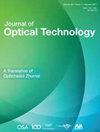Diffraction efficiency and form factor effect of holograms
IF 0.5
4区 物理与天体物理
Q4 OPTICS
引用次数: 0
Abstract
Subject of study. The influence of the form factor effect on the diffraction efficiency of holograms in various holographic materials is studied. Aim of study. The aim of the study is to review publications on the analysis of the diffraction efficiency of two-dimensional and three-dimensional holograms depending on the shape of the recording beams. Method. Holographic exposure of photosensitive media makes it possible to register the formed interference pattern in the medium in the form of periodic modulation of the refractive index, surface relief, optical absorption coefficient, or other parameters. The measurement and analysis of the diffraction efficiency showed its dependence on the degree of modulation of the recording medium and the shape of the recording beams. Main results. Based on the results of the review, it can be concluded that it is important to consider the cross-interaction of two nonlinear effects—the nonlinearity of the diffraction efficiency and the exposure nonlinearity over the hologram field. Manifestations of this cross-effect have been noticed by other authors but are often explained by other reasons. Its non-detectability and hidden effect can be explained by the manifestation only in the presence of two indicated nonlinearities simultaneously with the presence of local maxima in them. In all other cases, the form factor effect disappears. The areas of manifestation of the form factor effect in holographic experiments are shown as an effect that generates restrictions on holograms’ main “power” parameters, such as diffraction efficiency and optimal exposure. The manifestation of the form factor effect is immanent in the holographic recording of complex images because it cannot be eliminated completely but can only be weakened in the initial section of the exposure. Practical significance. Along with the indicated restrictive properties, the form factor effect allows in-situ measuring of holograms’ kinetics recording with high accuracy without involving additional complex equipment. This method was patented. Its influence can be significant; the form factor in holography cannot be attributed to small corrections of the main result. It manifests itself in the main “power” characteristics, similar to the fundamental manifestation of the form factor in the gravitational interactions of irregularly shaped bodies or interatomic interactions.全息图的衍射效率和形状因子效应
研究主题。研究了各种全息材料中形状因子效应对全息图衍射效率的影响。研究目的。本研究的目的是回顾有关二维和三维全息图的衍射效率随记录光束形状的分析的出版物。方法。光敏介质的全息曝光使得以折射率、表面起伏、光学吸收系数或其他参数的周期性调制的形式在介质中记录形成的干涉图样成为可能。对衍射效率的测量和分析表明,衍射效率与记录介质的调制程度和记录光束的形状有关。主要的结果。综上所述,考虑衍射效率非线性和曝光非线性这两种非线性效应在全息场中的相互作用是十分重要的。这种交叉效应的表现已被其他作者注意到,但通常用其他原因来解释。它的不可检测性和隐藏效应只能用两个指示的非线性同时存在且其中存在局部极大值的表现来解释。在其他情况下,外形因素的影响就消失了。在全息实验中,形状因子效应表现为对全息图的主要“功率”参数(如衍射效率和最佳曝光)产生限制的效应。形状因子效应的表现在复杂图像的全息记录中是固有的,因为它不能完全消除,而只能在曝光的初始部分减弱。现实意义。与指示的限制性特性一起,形状因子效应允许在不涉及额外复杂设备的情况下高精度地测量全息图的动力学记录。这种方法获得了专利。它的影响可能是巨大的;全息摄影的外形因素不能归因于主要结果的小修正。它表现在主要的“力”特征上,类似于形状因子在不规则形状物体的引力相互作用或原子相互作用中的基本表现。
本文章由计算机程序翻译,如有差异,请以英文原文为准。
求助全文
约1分钟内获得全文
求助全文
来源期刊
CiteScore
0.90
自引率
25.00%
发文量
66
审稿时长
3-8 weeks
期刊介绍:
The journal publishes design details of a diversity of optical instruments, along with a strong section on computational optics useful to engineers, mathematicians, and physicists, as well as optical scientists. Issues of the English translation volume are published by OSA and appear at the same time as the Russian language edition, Opticheskii Zhurnal, which is produced by the Vavilov State Optical Institute

 求助内容:
求助内容: 应助结果提醒方式:
应助结果提醒方式:


